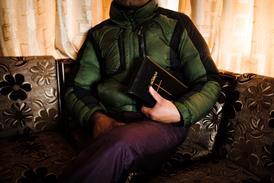Thousands of pilgrims will soon gather in Jerusalem to witness the Orthodox Church's biggest miracle. But is it real?

Every Orthodox Holy Saturday in Jerusalem’s Church of the Holy Sepulchre, thousands gather to witness a flame “miraculously” appearing in the tomb of Jesus.
Orthodox Christians believe it’s a potent symbol of the resurrection.
It’s the Church's most important miracle. And it’s believed to have been happening annually for the past 1,200 years.
The ritual begins with the Greek Orthodox Patriarch of Jerusalem (or another Orthodox archbishop), descending into the empty tomb of Christ within the church and reciting special prayers. A non-Orthodox Christian is also said to examine the edicule (a small structure surrounding the tomb) to make sure no oil lamps have been left burning inside that the patriarch could use to light his candles.
In the crowded church above the tomb and surrounding the edicule, the faithful chant with one voice “Kyrie eleison” (Lord, have mercy). The wait might be long or short but eventually a light is said to appear in the tomb where the patriarch has been praying alone. He then lights his candles from this miraculous flame and, accompanied by the pealing of bells, emerges to spread the fire among the crowd. The oncedark church becomes illuminated by the miraculous Holy Fire.
It is said that for the first several minutes the fire burns, but does not consume. During this time, many of the faithful bathe their faces and hands in the flame, apparently without being harmed. The flame is passed from candle to candle and then placed in lanterns so that it can be spread far and wide.
In 2017, for the first time, lanterns carrying the Holy Fire arrived in the United States and the United Kingdom. Facebook groups such as “Come Receive the Holy Fire!” allowed grassroots Orthodox believers to connect and share the fire. Of the 300,000 Russians in London, around half are thought to participate in Russian Orthodox Easter services. The faithful were permitted to light their own candles from the Holy Fire and take it home to light their own prayer corners.
A long history
When the award-winning Guardian journalist Victoria Clark travelled to Jerusalem to observe these remarkable events she reported “gasps and cheers and sobs and tears” inside the church and described an “overwhelming” level of emotion coupled with a “suffocating” heat from the number of flames.
She writes in her book Holy Fire: The Battle for Christ’s Tomb (Macmillan): “The earliest recorded reference to the miracle is Muslim and dates from the early ninth century… Its author simply tells of a bright white fire spontaneously appearing inside the shrine as if sent from heaven, and of Christians lighting their candles from the Greek patriarch’s Holy Fire before rampaging home in triumph, brandishing their divine favour and shouting ‘Hasten to the religion of the cross!’”
It is believed that the miracle of Holy Fire was a contributing factor towards the persecution of Christians and eventual destruction of the original Church of the Holy Sepulchre by Muslims in 1009.
Tradition dictates that a disgruntled priest who was bitter at being passed over for promotion had told the ruling Muslim caliph that a priest simply “greased the chain of iron that held the lamp over the tomb with oil of balsam” and, once the shrine had been sealed, “applied a match through the roof to the other extremity of the chain” so that “the fire descended immediately to the wick of the lamp and lighted it”.
The caliph believed the priest’s story and decided to end the apparent fraud by destroying the church. It was rebuilt 40 years later at great financial expense by the Byzantine emperor Constantine IX Monomachos and Patriarch Nicephorus of Constantinople.
Divide and conquer
In 1054 the Church divided between Orthodox in the East and Roman Catholic in the West. This break in communion lasts to this day and the ongoing Holy Fire miracle is taken by some as evidence that God is at work in the Orthodox East, not in the Catholic West.
But it wasn’t always this way. In 1095 at the Council of Clermont, Pope Urban II, having received a request for assistance from the Orthodox East, called upon the Catholic West to take up arms in the First Crusade. In his speech he even references the “yearly miracle” of Holy Fire. The divide in Christianity was still young at this time; the Orthodox were asking for help and Urban wanted to assist.
But two centuries later, Pope Gregory IX denounced the miracle of Holy Fire as bringing disgrace to God’s name for the way in which the Orthodox were benefiting materially from it. What had happened? In the intervening years six crusades had occurred and ultimately failed, and for some of that time the Holy Land had been ruled by Catholic monarchs. Orthodox apologists believe that two Catholic priests died in the eleventh century as God’s punishment for trying to obtain the Holy Fire for themselves, mimicking the account in Leviticus 10:1-3 where Aaron’s sons Nadab and Abihu are killed by God for offering unauthorised fire.
It is thought that between 1099, when the crusaders took Jerusalem, and 1187, when the church was lost to Saladin, the Roman Catholic Patriarch of Jerusalem tried but failed to replicate the miracle of Holy Fire.
As the divide between Eastern and Western Christianity endured so did the enmity between them. Following the failure of the crusades it is not surprising that the Holy Fire miracle faded from Western imaginations. When its time came, the Protestant Reformation rejected as fraudulent many of the relics and miracles so it is no surprise that the miracle of Holy Fire was viewed as yet another vain superstition of the past.
Holy fire or human fraud?
Writing in the 19th Century, the evangelical missionary to the Holy Land, Rev John Nicolayson said the supposed miracle was evidence the city of Jerusalem desperately needed to hear the gospel: “If anything especial need be urged in favour of a missionary settlement in Jerusalem, this and other similar perversions and mockeries of the truth and of sacred things, furnish a most urgent plea. It is impossible to witness the thousands who flock together here on this occasion as wholly given to idolatry, so blindly led to the service of dumb idols, and all of this in the name of Christianity, without feeling one’s spirit stirred within one.”
Nicolayson was not the first Protestant pastor to take exception to the miracle. Henry Maundrell (1665– 1701), an academic at the University of Oxford and later a Church of England clergyman, served as chaplain to the Levant Company in Syria and witnessed the claimed miracle. In his journal Journey from Aleppo to Jerusalem at Easter A.D. 1697 he wrote: “The Latins take a great deal of pains to expose this ceremony, as a most shameful imposture, and a scandal to the Christian religion; perhaps out of envy, that others should be the masters of so gainful business; but the Greek and Armenians pin their faith upon it, and make their pilgrimages chiefly upon this motive.”
With regards to the ability of the fire to not burn those that touch it he adds: “Those that got the fire applied it immediately to their beards, faces, and bosoms, pretending that it would not burn like an earthly flame; but I plainly saw, none of them could endure this experiment long enough to make good that pretension.”
Today, many Protestants visiting the Holy Land prefer the Garden Tomb as an alternative site to the Church of the Holy Sepulchre to remember the crucifixion and resurrection. For many Protestants not only is the Holy Fire fraudulent but the location of the Church of the Holy Sepulchre itself is wrong.
Victoria Clark recounts a conversation she had with Orthodox Bishop Theophanis in which she asked about the miracle. He replied: “In this ceremony we are offering created fire and from it comes uncreated light, by the grace of the Holy Spirit…before the ceremony begins, a kantila – a little oil lamp – is placed, already lit, on the tomb. The patriarch lights his candle from it while he says a special prayer.”
Bishop Theophanis likens the miracle to Holy Communion when the bread and wine becomes the body and blood of Christ (transubstantiation/ metousiosis). The natural is transformed into the supernatural. In his mind the Holy Fire really is a miraculous fire because the prayer has changed it from ordinary fire to Holy Fire.
But this is definitely not the official position of the Orthodox Church. The official website for the Patriarch of Jerusalem states that “he places a piece of cotton on the Holy Tomb and miraculously it lights up. With it the Patriarch lights the candles and exits the Holy Edicule”.
If Bishop Theophanis’ version is to be accepted then there is no actual miracle. The flame does not appear. The candles do not light themselves and the pilgrims waiting outside the tomb are gullible and naïve. The Holy Fire is nothing more than an ordinary flame and a special prayer. If this is true then the hierarchy of the Orthodox Church is deliberately misleading the faithful.
Language like “uncreated fire” is totally foreign to Western Christian experience and is another reason why this miracle is not understood in the West. For Orthodox Christians the uncreated light is the visible energies of God – other examples include the burning bush, the light that transfigured both Moses and Jesus, the light that blinded Paul at his conversion and the fire that descended upon the apostles at Pentecost.
The aim of the Christian life in Orthodoxy is union with God and this happens through experiencing the uncreated light of God and becoming transfigured by it. Western Christianity does not speak about God or the Christian life in these terms. Protestants especially wonder if the goal of seeking the uncreated light through contemplation owes more to Neoplatonism than early Christianity. Neoplatonism heavily influenced many well-known Church Fathers such as St Augustine and Origen. Their works have had a lasting influence on both Eastern Orthodox and Catholic spirituality, especially regarding the development of contemplative and mystical practices and theology.
Christ our light
Whether a genuine miracle the Western Church has ignored or simply the blessing of natural fire to become something more, Holy Fire is one of the longest-held Easter traditions in Christianity.
For some it proves the authenticity of Eastern Orthodoxy and demonstrates that God only works through the Orthodox Church. To others it is the worst kind of fraud – nothing but sheer manipulation of Christians by powerful church leaders.
But wherever we stand, Easter is the season where all Christians should join in remembering how Jesus Christ, the light of the world, won a victory over the forces of darkness by his resurrection from the dead. May Jesus Christ be our focus this season.
Matthew Winbow works full-time for a Christian charity and serves as a pastor at Discovery Church in Swindon






























